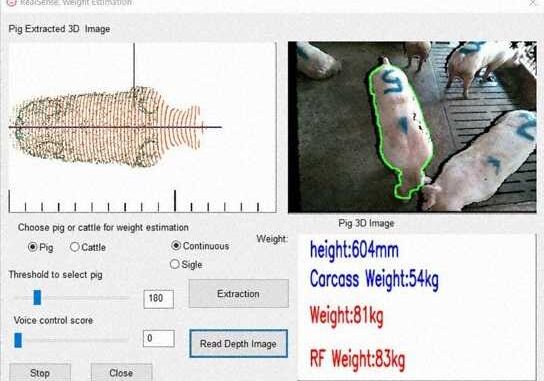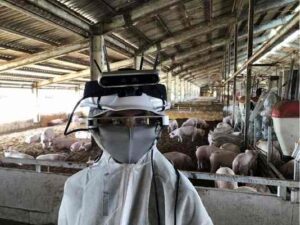
Visits: 61
– A screen with data collected by the glasses is seen in this image. Credits: University of Miyazaki.
Minapim by Hernan Valenzuela: The engineering department at Miyazaki University in Japan has developed a set of AI glasses (artificial intelligence) and augmented reality technology to visually measure the body mass of pigs.
As delivering different sizes of pigs simultaneously leads to lost profits, managing pigs to be reared uniformly is an important task on pig farms.
The AI glasses, devised by Professor Kikuhito Kawasue of Miyazaki University’s Faculty of Engineering, allow simple visual estimates of the weight of a pig as a prepared carcass, which influences the animal’s marketing prices.

Estimated size is used to select suitable feed for the pig. The new mechanism that drives the pig in the proper direction for feeding is also presented.
There is no precedent anywhere in the world for equipment like this, and the devices are expected to lighten the workload of farmers and generate a safer income for them.
According to Professor Kawasue, if a pig weighs 115 kg at the embarkation point, it is highly likely to get the highest grade. But because pigs consume about 3 kg of feed a day and also need to drink about 15 liters or more of water, there can be significant deviations from their actual body weight.
Until now, putting pigs on the scale required hard work by two or three people. But with glasses, a person can apparently quickly and accurately gauge the weight of animals.
The proposed mechanism works robustly in the poor environment of a pig farm, without disrupting the feeding cycles of pigs on the farms.
The system reduces labor cost and enables efficient feeding cycles when considering the size of a pig.
AI glasses are made from a combination of technologies, including a 3D camera to take measurements and smart glasses to display numerical data.
To calculate the potential carcass weight, the body shape data of a pig collected by the 3D camera is compared to a standard model. The estimated body mass appears on the smart glasses in real time.
The margin of error is supposedly in single-digit percentages, and an international patent application is underway.
Professor Kawasue said, “I want to make this product a commercial product in at least two years.” He says he will investigate in the future how to improve the device’s accuracy.
Sources: Mizayaki Univ. by Kenta Somatani Scopus
Related Article: IOT / AI / Nano – Food Technology – $ 6.5 Trillion USD Market!
Leave a Reply